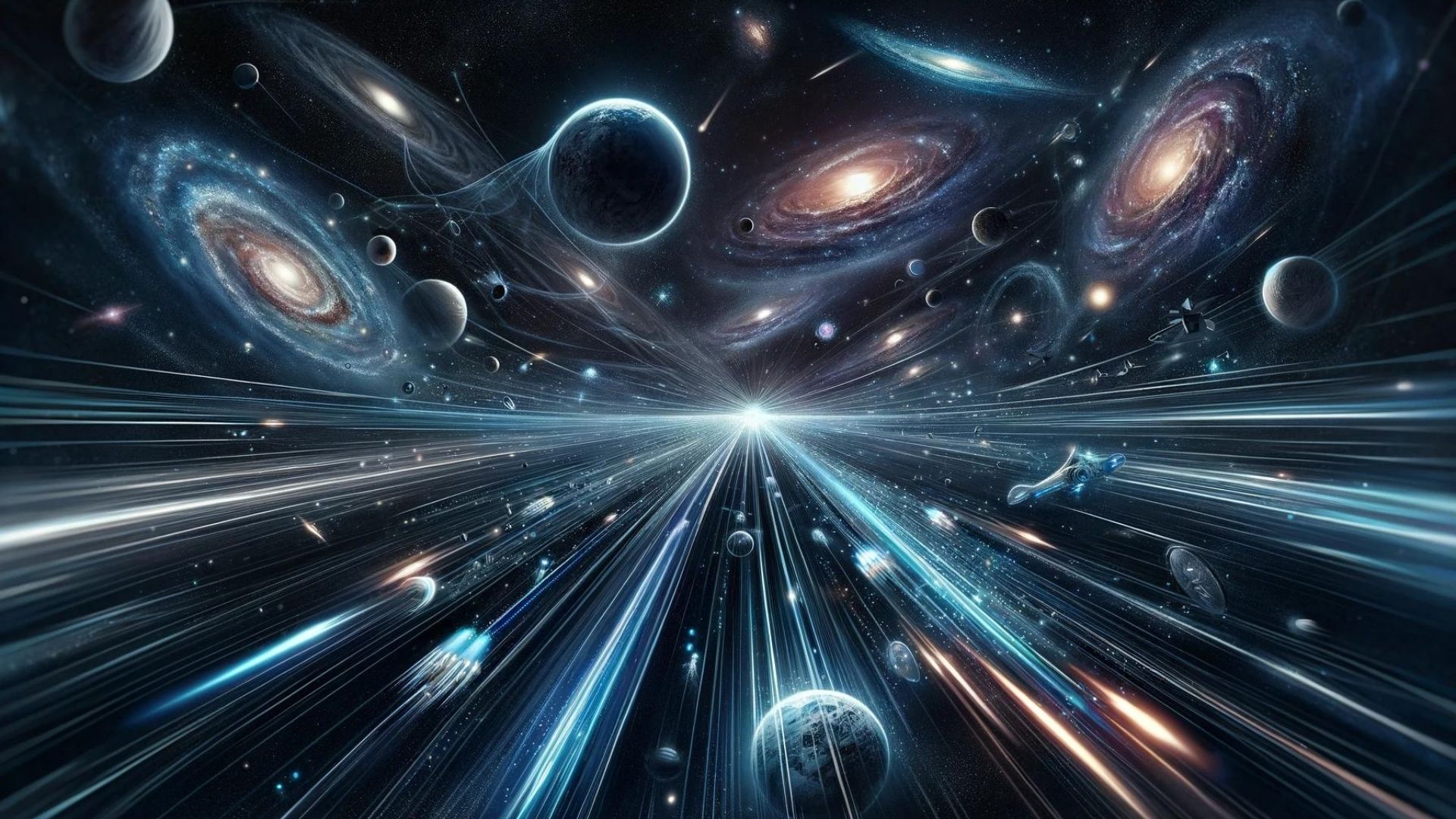Article Audio
The Everyday Speedster: Light
Picture this: you flick on a light switch. The room floods with light seemingly instantaneously. Sunlight takes about 8 minutes to reach Earth, but still, light zips around the cosmos at breakneck speed – roughly 186,282 miles per SECOND. Mind-boggling, right?
Yet, here’s the shocker: no matter how powerful your engine or how sleek your spaceship, the speed of light is an unbreakable barrier.
Blame It On Einstein (Kind Of)
This is where Albert Einstein shook things up. His revolutionary theory of relativity turned our understanding of space and time upside down. Here’s the gist:
- Nothing but Relative: Everything is relative, including speed. There’s no fixed point in the universe to judge everything against.
- Spacetime is Flexible: Mass distorts the fabric of spacetime itself. Think of a bowling ball on a trampoline – that’s what planets and stars do!
- The Faster You Go, the Heavier You Get: As you approach light speed, your mass increases exponentially. It’s NOT just a feeling – your actual stuff gets heavier!
So, What’s Light Got That I Don’t?
Light particles (photons) are unique. They have zero mass. To get ANY object with mass to light speed requires an infinite amount of energy. The closer you get, the more energy needed, the heavier you become – it’s a cosmic treadmill you can never win.
Mind-Bending Consequences
If you could hit light speed, crazy things would happen:
- Time Freeze: Time slows down for you relative to someone stationary. Hop on a near-light-speed spaceship for a year, come back, and decades might have passed on Earth!
- Squished Space: Distances would shrink in the direction you’re traveling. It’s not an illusion – spacetime compresses for you.
The Cosmic Rulebook
The speed of light isn’t just about going fast. It’s woven into the laws of the universe. If it could be exceeded, you’d break causality (effect happening BEFORE its cause!). Imagine shooting a target before firing the gun… it upends our understanding of how reality operates.
While it’s a bummer for sci-fi dreams of zipping between galaxies, the speed of light preserves the order of the universe. Plus, it leaves room for mind-blowing phenomena like black holes and those trippy time dilation effects for intrepid space adventurers (should they get close to reaching that limit!).
Want to explore further?
Search for terms like “special relativity,” “time dilation,” and “spacetime” to uncover even wilder implications of the cosmic speed limit!
Why Should You Care?
- Understanding the Universe: The speed of light is woven into the fabric of reality. Grasping it means understanding how crazy things like light beams, distant galaxies, and even time itself works.
- Limits of Sci-Fi: Knowing this makes you a savvy consumer of science fiction, spotting when movies bend the rules too far.
- Appreciating the Everyday: The speed of light is mind-bending, but it also impacts things like GPS accuracy and makes sunlight possible!
- The Thrill of Big Questions: Sometimes learning raises more questions than answers. That’s part of the fun with science!
Key Takeaways
- Speed is relative: There’s no fixed reference point in the universe for absolute speed.
- Light = Ultimate Speed: Only zero-mass particles like light can reach this limit.
- Mass Matters: As you approach light speed, your mass skyrockets, limiting further acceleration.
- Spacetime is Weird: Time dilation and space compression become real for near-light-speed travelers.
- Causality is Key: Exceeding light speed would mess with cause-and-effect, upending how the universe works.
Keywords with Definitions
- Speed of light: The speed at which light travels in a vacuum (empty space): roughly 186,282 miles per second.
- Cosmic Speed Limit: The maximum velocity anything can travel, set by the speed of light.
- Albert Einstein: Physicist who developed the theories of special and general relativity.
- Theory of Relativity: Revamped our understanding of space, time, and gravity. Space and time are not separate, but interwoven into spacetime.
- Mass: The amount of matter an object contains.
- Spacetime: The four-dimensional fabric of the universe: three dimensions of space, one of time.
- Photon: A particle of light, having both energy and momentum, but zero mass.
- Time dilation: The phenomenon where time slows down for someone moving at high speed relative to a stationary observer.
- Causality: The principle that one event (the cause) must precede another event (the effect).
- Black hole: A region of spacetime where gravity is so intense that not even light can escape.
Frequently Asked Questions (FAQs)
Could some undiscovered particle travel faster than light?
While tantalizing in theory, it would severely disrupt our understanding of physics.
Do spaceships get meaningfully heavier as they go faster?
Measurably yes, but currently only significantly noticeable for subatomic particles.
Does the speed of light explain why my GPS is sometimes wrong?
Totally! GPS needs precise time calculations that factor in time dilation experienced by satellites.
Myth Buster
Myth: If I exceeded light speed, I’d simply vanish.
Reality: It’s IMPOSSIBLE to reach the speed of light (for anything with mass), let alone exceed it. You’d get infinitely heavier first!
Let’s Talk!
- What’s the most mind-blowing thing about time dilation for you? Why?
- If breaking the light speed barrier WERE possible, what’s the first place you’d zip off to?
- How might our lives TODAY be different if the speed of light were much slower?
Share your thoughts in the comments below!











0 Comments